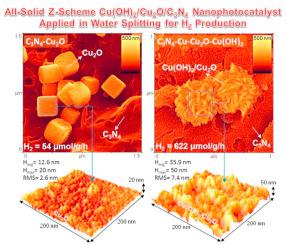当前位置:
X-MOL 学术
›
Sol. Energy Mater. Sol. Cells
›
论文详情
Our official English website, www.x-mol.net, welcomes your
feedback! (Note: you will need to create a separate account there.)
Sonoprecipitation design of novel efficient all-solid Z-Scheme Cu(OH)2/Cu2O/C3N4 nanophotocatalyst applied in water splitting for H2 production: Synergetic effect of Cu-Based cocatalyst (Cu(OH)2) and electron mediator (Cu)
Solar Energy Materials and Solar Cells ( IF 6.3 ) Pub Date : 2021-01-01 , DOI: 10.1016/j.solmat.2020.110772 Saeed Mahzoon , Mohammad Haghighi , Mostafa Nowee , Hossein Zeinalzadeh
Solar Energy Materials and Solar Cells ( IF 6.3 ) Pub Date : 2021-01-01 , DOI: 10.1016/j.solmat.2020.110772 Saeed Mahzoon , Mohammad Haghighi , Mostafa Nowee , Hossein Zeinalzadeh

|
Abstract Herein, we rationally designed and fabricated the visible-light-driven Cu(OH)2/Cu2O/C3N4 photocatalyst with stable and highly efficient novel all-solid Z-scheme photocatalytic performance. It was observed that selectively fabrication of Cu(OH)2 nanoclusters on the surface of Cu2O as well as the in-situ formation of elemental Cu at the interface of Cu2O/C3N4 effectively enhanced the photoactivity of the Cu(OH)2/Cu2O/C3N4 (622 μmol H2/h/g) compared to pure C3N4 nanosheets (6 μmol H2/h/g), bare Cu2O (21 μmol H2/h/g) and even Cu2O–C3N4 heterostructure (54 μmol H2/h/g) by 103, 30, and 11.5 times, respectively. Based on the BET, DRS, PL, and electrochemical analyses, the superior performance of Cu(OH)2/Cu2O/C3N4 was proved to be mainly attributed to efficient charge carrier separation as well as high surface area of C3N4 nanosheets, noticeable visible-light response of Cu2O and SPR effect of elemental Cu. Additionally, radical species trapping was applied to more deeply study the charge carrier transfer behavior of the samples. This confirmed charge separation of Cu(OH)2/Cu2O/C3N4 followed the Z-scheme mechanism where interlayer elemental Cu as non-precious electron mediator and Cu(OH)2 nanoclusters as electron sink and noble-metal-free cocatalyst synergistically played a key role in accelerating charge carrier transfer and retarding electron-hole recombination. The current study is anticipated to open a new route for the rational design of Cu2O-based Z-scheme photocatalytic systems while taking the advantages of integrative adopting of Cu-based electron mediator and cocatalyst.
中文翻译:

新型高效全固态 Z-Scheme Cu(OH)2/Cu2O/C3N4 纳米光催化剂的声沉淀设计用于水分解制氢:Cu 基助催化剂 (Cu(OH)2) 和电子介体 (Cu) 的协同效应
摘要 在此,我们合理设计并制备了可见光驱动的 Cu(OH)2/Cu2O/C3N4 光催化剂,该催化剂具有稳定高效的新型全固态 Z 型光催化性能。观察到在 Cu2O 表面选择性地制备 Cu(OH)2 纳米团簇以及在 Cu2O/C3N4 界面上原位形成元素 Cu 有效地增强了 Cu(OH)2/Cu2O/ C3N4 (622 μmol H2/h/g) 与纯 C3N4 纳米片 (6 μmol H2/h/g)、裸 Cu2O (21 μmol H2/h/g) 甚至 Cu2O–C3N4 异质结构 (54 μmol H2/h/g) 相比) 分别为 103、30 和 11.5 倍。基于 BET、DRS、PL 和电化学分析,证明 Cu(OH)2/Cu2O/C3N4 的优异性能主要归因于有效的电荷载流子分离以及 C3N4 纳米片的高表面积,Cu2O 的显着可见光响应和元素 Cu 的 SPR 效应。此外,自由基物种捕获被应用于更深入地研究样品的电荷载流子转移行为。这证实了 Cu(OH)2/Cu2O/C3N4 的电荷分离遵循 Z 型机制,其中层间元素 Cu 作为非贵重电子介体和 Cu(OH)2 纳米团簇作为电子汇和无贵金属助催化剂协同发挥作用在加速电荷载流子转移和延缓电子-空穴复合中起关键作用。目前的研究有望为合理设计Cu2O基Z型光催化体系开辟一条新途径,同时利用Cu基电子介体和助催化剂综合采用的优势。自由基物种捕获被应用于更深入地研究样品的电荷载流子转移行为。这证实了 Cu(OH)2/Cu2O/C3N4 的电荷分离遵循 Z 型机制,其中层间元素 Cu 作为非贵重电子介体和 Cu(OH)2 纳米团簇作为电子汇和无贵金属助催化剂协同发挥作用在加速电荷载流子转移和延缓电子-空穴复合中起关键作用。目前的研究有望为合理设计Cu2O基Z型光催化体系开辟一条新途径,同时利用Cu基电子介体和助催化剂综合采用的优势。自由基物种捕获被应用于更深入地研究样品的电荷载流子转移行为。这证实了 Cu(OH)2/Cu2O/C3N4 的电荷分离遵循 Z 型机制,其中层间元素 Cu 作为非贵重电子介体和 Cu(OH)2 纳米团簇作为电子汇和无贵金属助催化剂协同发挥作用在加速电荷载流子转移和延缓电子-空穴复合中起关键作用。目前的研究有望为合理设计Cu2O基Z型光催化体系开辟一条新途径,同时利用Cu基电子介体和助催化剂综合采用的优势。这证实了 Cu(OH)2/Cu2O/C3N4 的电荷分离遵循 Z 型机制,其中层间元素 Cu 作为非贵重电子介体和 Cu(OH)2 纳米团簇作为电子汇和无贵金属助催化剂协同发挥作用在加速电荷载流子转移和延缓电子-空穴复合中起关键作用。目前的研究有望为合理设计Cu2O基Z型光催化体系开辟一条新途径,同时利用Cu基电子介体和助催化剂综合采用的优势。这证实了 Cu(OH)2/Cu2O/C3N4 的电荷分离遵循 Z 型机制,其中层间元素 Cu 作为非贵重电子介体和 Cu(OH)2 纳米团簇作为电子汇和无贵金属助催化剂协同发挥作用在加速电荷载流子转移和延缓电子-空穴复合中起关键作用。目前的研究有望为合理设计Cu2O基Z型光催化体系开辟一条新途径,同时利用Cu基电子介体和助催化剂综合采用的优势。
更新日期:2021-01-01
中文翻译:

新型高效全固态 Z-Scheme Cu(OH)2/Cu2O/C3N4 纳米光催化剂的声沉淀设计用于水分解制氢:Cu 基助催化剂 (Cu(OH)2) 和电子介体 (Cu) 的协同效应
摘要 在此,我们合理设计并制备了可见光驱动的 Cu(OH)2/Cu2O/C3N4 光催化剂,该催化剂具有稳定高效的新型全固态 Z 型光催化性能。观察到在 Cu2O 表面选择性地制备 Cu(OH)2 纳米团簇以及在 Cu2O/C3N4 界面上原位形成元素 Cu 有效地增强了 Cu(OH)2/Cu2O/ C3N4 (622 μmol H2/h/g) 与纯 C3N4 纳米片 (6 μmol H2/h/g)、裸 Cu2O (21 μmol H2/h/g) 甚至 Cu2O–C3N4 异质结构 (54 μmol H2/h/g) 相比) 分别为 103、30 和 11.5 倍。基于 BET、DRS、PL 和电化学分析,证明 Cu(OH)2/Cu2O/C3N4 的优异性能主要归因于有效的电荷载流子分离以及 C3N4 纳米片的高表面积,Cu2O 的显着可见光响应和元素 Cu 的 SPR 效应。此外,自由基物种捕获被应用于更深入地研究样品的电荷载流子转移行为。这证实了 Cu(OH)2/Cu2O/C3N4 的电荷分离遵循 Z 型机制,其中层间元素 Cu 作为非贵重电子介体和 Cu(OH)2 纳米团簇作为电子汇和无贵金属助催化剂协同发挥作用在加速电荷载流子转移和延缓电子-空穴复合中起关键作用。目前的研究有望为合理设计Cu2O基Z型光催化体系开辟一条新途径,同时利用Cu基电子介体和助催化剂综合采用的优势。自由基物种捕获被应用于更深入地研究样品的电荷载流子转移行为。这证实了 Cu(OH)2/Cu2O/C3N4 的电荷分离遵循 Z 型机制,其中层间元素 Cu 作为非贵重电子介体和 Cu(OH)2 纳米团簇作为电子汇和无贵金属助催化剂协同发挥作用在加速电荷载流子转移和延缓电子-空穴复合中起关键作用。目前的研究有望为合理设计Cu2O基Z型光催化体系开辟一条新途径,同时利用Cu基电子介体和助催化剂综合采用的优势。自由基物种捕获被应用于更深入地研究样品的电荷载流子转移行为。这证实了 Cu(OH)2/Cu2O/C3N4 的电荷分离遵循 Z 型机制,其中层间元素 Cu 作为非贵重电子介体和 Cu(OH)2 纳米团簇作为电子汇和无贵金属助催化剂协同发挥作用在加速电荷载流子转移和延缓电子-空穴复合中起关键作用。目前的研究有望为合理设计Cu2O基Z型光催化体系开辟一条新途径,同时利用Cu基电子介体和助催化剂综合采用的优势。这证实了 Cu(OH)2/Cu2O/C3N4 的电荷分离遵循 Z 型机制,其中层间元素 Cu 作为非贵重电子介体和 Cu(OH)2 纳米团簇作为电子汇和无贵金属助催化剂协同发挥作用在加速电荷载流子转移和延缓电子-空穴复合中起关键作用。目前的研究有望为合理设计Cu2O基Z型光催化体系开辟一条新途径,同时利用Cu基电子介体和助催化剂综合采用的优势。这证实了 Cu(OH)2/Cu2O/C3N4 的电荷分离遵循 Z 型机制,其中层间元素 Cu 作为非贵重电子介体和 Cu(OH)2 纳米团簇作为电子汇和无贵金属助催化剂协同发挥作用在加速电荷载流子转移和延缓电子-空穴复合中起关键作用。目前的研究有望为合理设计Cu2O基Z型光催化体系开辟一条新途径,同时利用Cu基电子介体和助催化剂综合采用的优势。











































 京公网安备 11010802027423号
京公网安备 11010802027423号